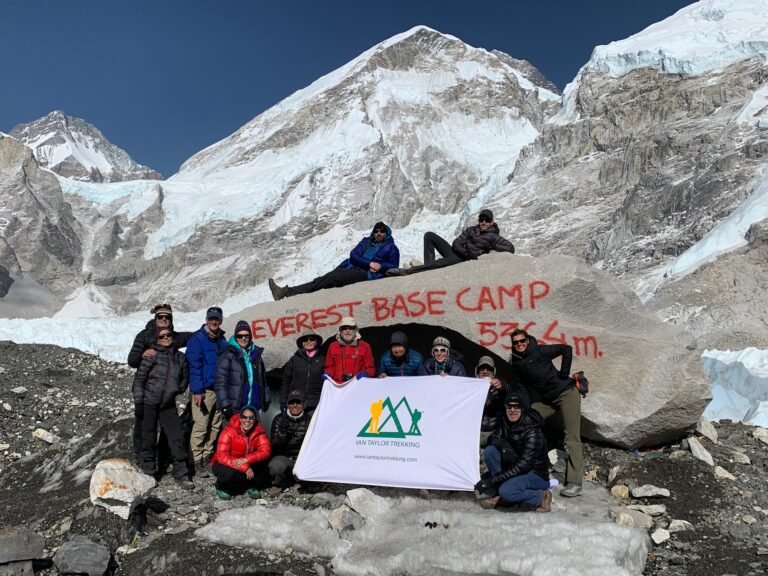Surviving the elements during the Everest Base Camp trekking is as much about preparation and adaptability as it is about physical endurance. The trek, known for its breathtaking scenery and extreme conditions, demands careful planning and awareness to tackle the diverse weather challenges you will encounter.
Starting from Lukla, you will immediately face the unpredictable weather patterns of the Himalayas. The trek begins in the lower altitudes where temperatures are relatively mild, but as you ascend, the climate shifts dramatically. You need to be prepared for a wide range of conditions, from warm days in the lush lower valleys to frigid temperatures at higher altitudes.
One of the most critical aspects of surviving the elements is having the right clothing and gear. Layering is essential; it allows you to adjust your body temperature as conditions change throughout the day. Invest in high-quality base layers that wick moisture away from your skin, insulating layers to retain heat, and an outer shell that provides wind and waterproof protection. A good quality down jacket and a pair of thermal gloves are indispensable for the colder sections of the trek.
Footwear is equally important. Your trekking boots should be sturdy, well-fitting, and waterproof to handle the varying terrain and potential snow or rain. Ensure they are broken in before the trek to avoid blisters and discomfort.
Weather at high altitudes can be particularly harsh and unpredictable. Temperatures can plummet well below freezing, especially at night. The key to managing this is proper gear and preparation. Ensure you have a sleeping bag rated for sub-zero temperatures and a tent or accommodation that offers adequate insulation. Be prepared for sudden weather changes, including heavy snow or rain, and know how to protect yourself from hypothermia and frostbite.
Acclimatization plays a crucial role in your ability to handle the elements. As you climb higher, the air thins, which can exacerbate the effects of cold and fatigue. Follow a gradual ascent plan, allowing your body time to adapt to higher altitudes. This includes taking acclimatization days where you hike to higher elevations during the day and return to lower altitudes to sleep.
Hydration is also critical. The dry, cold air at high altitudes can lead to dehydration faster than you might realize. Drink plenty of water, and use purification tablets or filters to ensure it is safe. Avoid alcohol and excessive caffeine, which can contribute to dehydration.
Mental preparation is just as important as physical readiness. The trek can be physically demanding and mentally challenging, especially when facing adverse weather conditions. Staying positive, flexible, and prepared to adapt to unexpected changes will help you manage the elements more effectively.
In summary, tackling the Everest Base Camp trek requires a comprehensive approach to gear, acclimatization, hydration, and mental fortitude. By preparing adequately for the varying weather conditions and being adaptable to the challenges you face, you’ll enhance your chances of a successful and safe adventure in one of the world’s most awe-inspiring environments.
Introduction to the Everest Base Camp Trek
The Everest Base Camp Trek 14 Days stands as one of the most iconic adventures in the world, offering a unique blend of breathtaking natural beauty and profound personal challenge. Located in the Khumbu region of Nepal, this trek takes you to the foot of Mount Everest, the highest peak on Earth, and provides a remarkable opportunity to experience the Himalayas in all their grandeur. The journey covers approximately 130 kilometers (80 miles) round-trip and usually takes 12 to 14 days, including acclimatization periods. Along the way, trekkers traverse diverse landscapes, from lush forests and terraced fields to stark, high-altitude deserts. The trek is not only about reaching the base camp but also about immersing yourself in the rich Sherpa culture, witnessing the stunning peaks like Lhotse and Ama Dablam, and overcoming the physical and mental challenges posed by the high-altitude environment. The reward for your effort is the spectacular view of Everest’s south face and the sense of achievement from having completed one of the world’s most revered trekking routes.
Understanding the Himalayan Climate
The Himalayan climate is as varied as its landscape, and understanding it is crucial for a successful Everest Base Camp trek. The trek spans several climate zones, each with distinct weather patterns. In the lower altitudes around Lukla and Phakding, you’ll encounter relatively moderate temperatures and occasional rain, especially during the monsoon season (June to September). As you ascend, the climate shifts dramatically. The middle elevations, including Namche Bazaar and Tengboche, experience cooler temperatures and varying degrees of precipitation. Winter months (December to February) can be particularly harsh with heavy snowfall and freezing temperatures.
In the higher altitudes, the climate becomes more extreme. The temperatures can drop below freezing, and conditions can change rapidly. Snowstorms and strong winds are common, especially from late autumn to early spring. Understanding these conditions is essential for preparing the right gear and ensuring safety. Always check weather forecasts before setting out and be ready for sudden changes. Proper preparation will help you manage the cold and avoid weather-related challenges during your trek.
Essential Gear for Extreme Conditions
Equipping yourself with the right gear is critical for surviving the extreme conditions of the Everest Base Camp trek. The high-altitude environment presents a range of challenges, including freezing temperatures, strong winds, and variable weather. Essential gear starts with a robust layering system. Base layers made from moisture-wicking materials help regulate body temperature and keep sweat away from your skin. Mid-layers, such as fleece or down jackets, provide insulation against the cold. An outer shell, including a waterproof and windproof jacket, protects against wind, rain, and snow.
Quality trekking boots with good ankle support and waterproofing are crucial for navigating rocky and snowy trails. Insulated gloves, a warm hat, and a balaclava will protect extremities from the biting cold. A sleeping bag rated for sub-zero temperatures is essential for staying warm during the night. Additionally, trekking poles can help with stability and reduce strain on your knees. Don’t forget to pack a headlamp, high-energy snacks, and a reliable first-aid kit. Investing in quality gear tailored for high-altitude trekking will ensure comfort and safety throughout your adventure.
Preparing for Altitude: Acclimatization Techniques
Acclimatization is a vital process for successfully trekking to Everest Base Camp, as the reduced oxygen levels at high altitudes can lead to altitude sickness if not managed properly. Gradual ascent is the key to effective acclimatization. Plan your trek with regular rest days, especially at key elevations like Namche Bazaar and Dingboche, to give your body time to adjust. During these acclimatization days, engage in short hikes to higher altitudes and return to sleep at lower levels to facilitate better adjustment.
Stay hydrated by drinking plenty of water, and avoid alcohol and caffeine, which can exacerbate dehydration. Eating a balanced diet rich in carbohydrates helps maintain energy levels. Pay attention to your body and monitor for symptoms of altitude sickness, such as headaches, nausea, and dizziness. If symptoms occur, it’s important to communicate with your guide and consider descending if necessary. Many trekkers also use medications like Diamox to prevent altitude sickness, but it should be used under medical guidance. Acclimatization techniques, combined with proper hydration, nutrition, and rest, are crucial for a safe and successful trek to Everest Base Camp.
The Importance of Physical Fitness
Physical fitness plays a crucial role in successfully tackling the Everest Base Camp trekking. The journey involves significant physical exertion, including long days of hiking at varying altitudes. A well-rounded fitness regimen should include cardiovascular exercises, such as running, cycling, or swimming, to build endurance and stamina. Strength training, particularly focusing on the legs and core, is essential for managing the trek’s demanding terrain.
Incorporate practice hikes into your training schedule, ideally with a weighted backpack, to simulate trekking conditions. This will help condition your body to the physical demands of the trek and improve your comfort with carrying gear. Flexibility exercises, such as stretching and yoga, can also enhance overall mobility and reduce the risk of injury.
Being physically fit not only improves your trekking performance but also aids in acclimatization and recovery. It helps you handle the altitude better, manage fatigue, and navigate challenging sections of the trail with greater ease. Preparing physically ensures that you can fully enjoy the trek, reduce the risk of injury, and successfully reach Everest Base Camp.
Navigating Weather Challenges During the Trek
Navigating the weather challenges during the Everest Base Camp trek is essential for a safe and enjoyable experience. The weather in the Himalayas is notoriously unpredictable and can change rapidly, with conditions varying significantly between lower and higher altitudes. At lower elevations, you may encounter moderate temperatures and occasional rain. However, as you ascend, temperatures drop, and the likelihood of snow and strong winds increases, particularly in the higher altitudes.
To effectively handle these weather challenges, stay informed about weather forecasts and be prepared for sudden changes. Layering your clothing is key; wear moisture-wicking base layers to manage sweat, insulating mid-layers to retain heat, and a waterproof, windproof outer layer to protect against rain and snow. A good quality hat, gloves, and thermal socks will further protect against the cold.
Adapt your trekking schedule to accommodate weather conditions. Be prepared to adjust your plans if severe weather is forecasted. It’s crucial to have a flexible itinerary to ensure you can safely navigate or delay treks if conditions become hazardous. Additionally, always carry essential gear like a headlamp and emergency blankets, and know how to use them in adverse conditions. By being prepared and adaptable, you can effectively manage the weather challenges and ensure a safer trekking experience.
Emergency Preparedness: What to Pack
Emergency preparedness is crucial for a safe Everest Base Camp trek, given the remote and challenging environment. Packing a comprehensive first-aid kit is essential. This kit should include items such as blister treatments, pain relievers, altitude sickness medication (like Diamox), antiseptics, and bandages. It’s also wise to carry a basic multi-tool for unexpected situations and an emergency whistle.
Additionally, include a personal locator beacon or satellite phone for emergency communication, as cellular service is unreliable in remote areas. Carry a headlamp with extra batteries, as it can be critical for navigating in low light or during emergencies. A compact, portable stove and food rations can provide sustenance if you are delayed or stranded.
Ensure you have a high-quality emergency blanket or bivvy bag, which can offer warmth if needed. Packing these emergency essentials will help you handle unforeseen situations and ensure that you can remain safe and self-sufficient during the trek. Prioritize safety by preparing for potential emergencies and being ready to act quickly if necessary.
Tips for Staying Warm and Dry
Staying warm and dry is essential for maintaining comfort and safety during the Everest Base Camp trek, especially given the varying weather conditions. Start with a proper layering system. Base layers made of moisture-wicking materials help keep sweat away from your body, reducing the risk of getting chilled. Add insulating layers, such as fleece or down jackets, to retain body heat. Finally, wear an outer shell that is both windproof and waterproof to protect against rain, snow, and wind.
For your extremities, ensure you have insulated gloves, a warm hat, and thermal socks. Gaiters can protect your lower legs and boots from snow and mud. Make use of waterproof covers for your gear and pack to keep your belongings dry in wet conditions.
During breaks or when you are resting, try to maintain warmth by moving regularly or using hand warmers. Avoid sitting directly on cold surfaces and use a sleeping pad with good insulation. Staying dry is equally important, as damp clothing and gear can lead to rapid heat loss. Regularly check and manage your clothing layers to ensure you’re not overheating, which can also lead to excessive sweating and subsequent chill. By following these tips, you can maintain warmth and dryness, enhancing your trekking experience.
Hydration and Nutrition on the Trail
Maintaining proper hydration and nutrition is crucial for enduring the physical demands of the Everest Base Camp trek. At high altitudes, your body requires more water to stay hydrated, and the dry air can exacerbate dehydration. Aim to drink at least 3 to 4 liters of water daily, and consider using purification tablets or filters to ensure water safety from natural sources.
For nutrition, focus on a balanced diet rich in carbohydrates, proteins, and healthy fats to sustain your energy levels throughout the trek. High-energy snacks such as nuts, dried fruits, and energy bars are convenient for quick boosts. Meals should include a mix of vegetables, lean proteins, and whole grains to provide essential nutrients and energy.
Be mindful of your diet to avoid gastrointestinal issues, which can be more common at high altitudes. Eat familiar foods to reduce the risk of stomach upset and avoid excessive amounts of caffeine or alcohol, which can contribute to dehydration. Proper hydration and nutrition will help you maintain strength and stamina, which are critical for handling the trek’s physical demands and altitude challenges.
Dealing with Common Trekking Injuries
Dealing with common trekking injuries efficiently can significantly impact your overall experience and safety on the Everest Base Camp trek. One of the most common issues is blisters, often caused by ill-fitting boots or excessive friction. Prevent blisters by wearing well-fitted, broken-in boots and moisture-wicking socks. If you do develop blisters, treat them promptly with blister pads or bandages and avoid popping them to reduce the risk of infection.
Another frequent issue is joint and muscle pain due to the strain of trekking on uneven terrain. To manage this, use trekking poles to reduce stress on your knees and legs, and perform regular stretching exercises to maintain flexibility and prevent cramps. Carry over-the-counter pain relievers and anti-inflammatory medication to manage discomfort.
Altitude sickness is another significant concern. It is essential to recognize the symptoms early, such as headaches, dizziness, and nausea, and take appropriate measures like acclimatization and descent if necessary. Ensure you are familiar with the basic first-aid procedures for these common injuries and consult with your guide or a medical professional if needed. Proper preparation and proactive management of these injuries will enhance your trekking experience and safety.
Mental Resilience: Staying Positive
Maintaining mental resilience is crucial for a successful Everest Base Camp trek, as the journey is as much a psychological challenge as it is a physical one. Trekking in the Himalayas involves long days of hiking, high-altitude conditions, and unpredictable weather, all of which can test your endurance and mental fortitude. Staying positive amidst these challenges can significantly impact your overall experience and success.
One key strategy for building mental resilience is setting realistic expectations and focusing on achievable goals. Break down the trek into manageable segments and celebrate small victories along the way. This approach helps in maintaining motivation and perspective, especially when faced with tough stretches or adverse conditions.
Developing a positive mindset also involves preparing for the ups and downs of the trek. Anticipate challenges and view them as opportunities for growth rather than obstacles. Engage in positive self-talk and use techniques such as visualization to maintain focus on the ultimate goal. Building a support network with fellow trekkers can also provide encouragement and shared strength during difficult moments.
Incorporating mindfulness and stress-reduction techniques, such as deep breathing exercises, can help manage anxiety and keep you centered. By adopting these mental strategies, you can enhance your ability to cope with the trek’s demands, ensuring a more fulfilling and positive adventure.
Safety Protocols and Communication
Safety is paramount during the Everest Base Camp trek, given the remote and demanding nature of the environment. Implementing robust safety protocols and maintaining effective communication are essential for ensuring a safe trekking experience.
Before setting out, ensure you are well-informed about the trek’s route, weather conditions, and potential hazards. Carry a comprehensive first-aid kit, and be familiar with basic first-aid procedures. Additionally, equip yourself with a personal locator beacon or satellite phone for emergency communication, as cellular coverage can be unreliable in the remote regions of the Himalayas.
Adhere to established safety guidelines, such as gradual acclimatization to prevent altitude sickness and regular check-ins with your trekking group. Establish clear communication channels with your guide and fellow trekkers. Inform your guide of any health concerns or unusual symptoms promptly, and follow their advice regarding safety protocols.
Staying connected with your guide and team ensures that any emerging issues can be addressed quickly and effectively. By prioritizing safety and maintaining open lines of communication, you can navigate the trek more securely and respond to emergencies with confidence.
Trekkers’ Etiquette in the Himalayas
Respectful behavior and proper etiquette are fundamental when trekking in the Himalayas, both for preserving the local environment and fostering positive interactions with the Sherpa community. Trekkers are encouraged to follow cultural norms and show appreciation for the rich traditions of the region.
When interacting with local villagers, including Sherpas, greet them warmly and acknowledge their hospitality. It’s important to ask for permission before taking photos of individuals or their property, and to dress modestly, particularly in religious or cultural sites.
On the trail, adhere to Leave No Trace principles. This means packing out all waste, avoiding damage to vegetation, and sticking to established paths to minimize environmental impact. Be considerate of other trekkers by keeping noise levels down and yielding the trail to those ascending.
Supporting local businesses, such as teahouses and shops, helps contribute to the community’s economy. Show appreciation for the services provided by guides and porters, who play a crucial role in ensuring a successful trek. Practicing these etiquette guidelines will enhance your trekking experience and contribute to a positive and respectful trekking environment.
Enriching Your Trekking Experience
Enhancing your Everest Base Camp trek involves more than just reaching the destination; it’s about immersing yourself in the experience and creating lasting memories. Embrace the opportunity to explore the diverse landscapes, engage with the local culture, and connect with fellow trekkers.
Take time to appreciate the natural beauty of the region. Pause to admire the stunning vistas, from lush valleys to towering peaks, and capture these moments with thoughtful photography. Engage with the local Sherpa community to gain insight into their traditions and way of life. Participating in cultural events or learning about local customs can enrich your understanding and appreciation of the trek.
Interact with fellow trekkers to share stories, tips, and encouragement. Building connections with others on the trail can provide a sense of camaraderie and mutual support. Attend to your personal interests and needs, whether through journaling, meditation, or simply enjoying quiet moments of reflection.
By fully immersing yourself in the experience and being open to new encounters, you can transform your Everest Base Camp trek into a profound and enriching adventure.
Conclusion: Embracing the Adventure and Overcoming Challenges
The Everest Base Camp trek is a journey of extraordinary beauty and personal growth. Embracing the adventure requires more than physical preparation; it involves cultivating mental resilience, adhering to safety protocols, and engaging respectfully with the environment and local culture.
The challenges you face, from navigating unpredictable weather to managing physical exertion and altitude changes, contribute to a transformative experience. Each step of the trek, from the initial ascent to the final arrival at base camp, is an opportunity to test your limits and discover your inner strength.
Reflecting on the journey, you’ll likely find that the difficulties faced and the obstacles overcome add depth to the adventure. The rewards are not only the stunning views and the sense of accomplishment but also the personal growth and lasting memories forged along the way.
By embracing the challenges and savoring the journey, you ensure that the Everest Base Camp trek becomes a meaningful and memorable chapter in your life’s adventures.

Daniel J. Morgan is the founder of Invidiata Magazine, a premier publication showcasing luxury living, arts, and culture. With a passion for excellence, Daniel has established the magazine as a beacon of sophistication and refinement, captivating discerning audiences worldwide.





